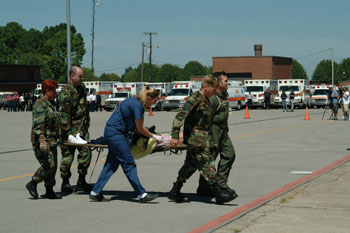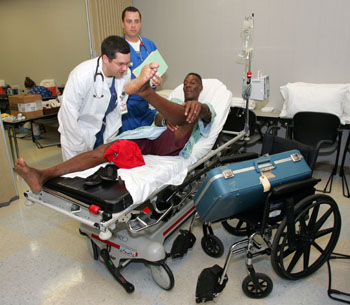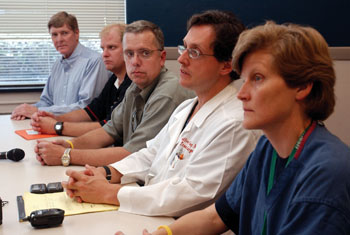
Vanderbilt’s Cristina Estrada, M.D., performs a rapid triage on a patient who was among those airlifted to Nashville from the Gulf Coast on Saturday.
photo by Mark Tankersley
Hurricane relief efforts intensify

Leroy Crawford, from New Orleans, points out his mosquito bites to Jason Thurman, M.D., and Stoney Greenlee, R.N. The suitcase beside him contains all the possessions Crawford and his wife, Diane, were able to salvage.
photo by Neil Brake

From left to right, Bobby Frist, M.D., Leland Lancaster, M.D., Stephen Guillot Jr., Jeff Guy, M.D., and Robin Hemphill, M.D., talk to the local media about receiving hurricane victims as patients at Vanderbilt and other area hospitals.
photo by Dana Johnson
Vanderbilt University Medical Center's response to the Hurricane Katrina disaster continued to gain steam this week.
Among the major developments were:
• The arrival on Saturday of a military transport plane filled with more than 100 evacuees of the devastated Gulf Coast region. Vanderbilt personnel provided key leadership for the handling of the influx of patients, 21 of whom were sent to Vanderbilt University Hospital and the Monroe Carell Jr. Children's Hospital at Vanderbilt.
A large team of Vanderbilt and Veterans Administration medical personnel established a triage facility at Berry Field to assess the condition of the incoming patients before they were taken to various hospitals throughout Nashville.
At VUH, more than 50 additional staff members were on hand to process and greet the arriving patients, who presented with a variety of problems related primarily to exposure.
Other injuries included broken bones and people dealing with chronic health conditions who had been without access to medications or care for several days. Most of the patients were elderly, though the sickest patient was a young man in urgent need of dialysis.
• LifeFlight sent a helicopter and crew — four flight nurses, two pilots and one maintenance officer — to Hattiesburg, Miss., to assist in rescue efforts and patient transport. Also, LifeFlight's fixed wing aircraft has been in service, shuttling patients out of the stricken region.
• The Middle Tennessee Medical Reserve Corps (MTMRC), created by the School of Nursing, is providing around-the-clock staffing for Nashville's largest shelter for hurricane evacuees, at Crievewood Baptist Church. The corps is also collecting medical supplies at Nashville's Municipal Auditorium daily from 7 a.m. to 7 p.m.
• Several VUMC faculty and staff members have been deployed to the Gulf Coast by numerous agencies, including the National Guard, the Federal Urban Search and Rescue Team and the Tennessee Disaster Medical Assistance Team.













